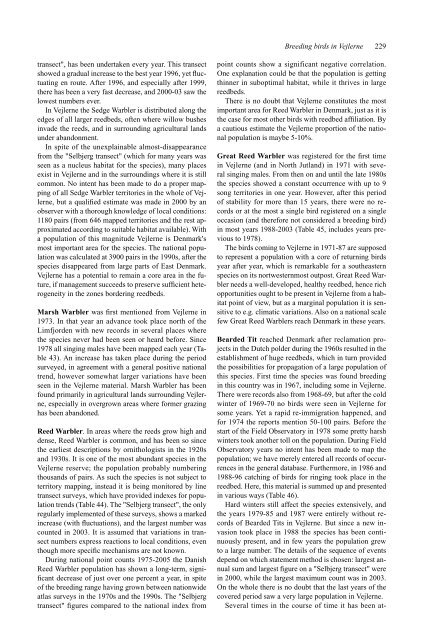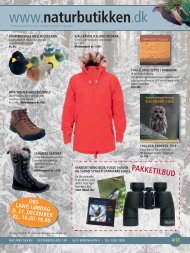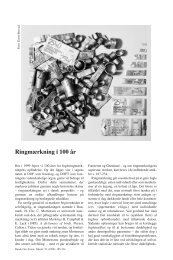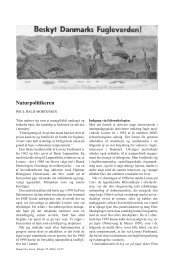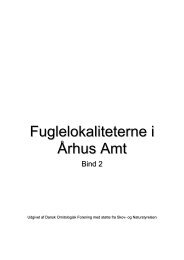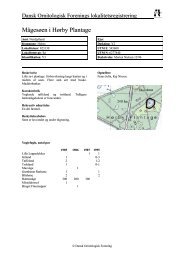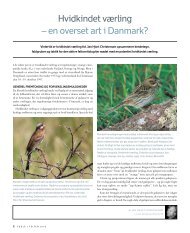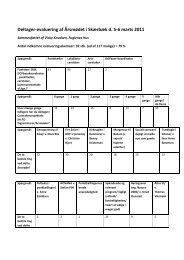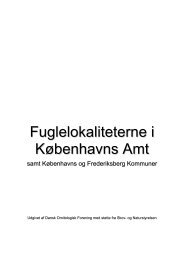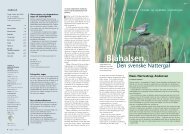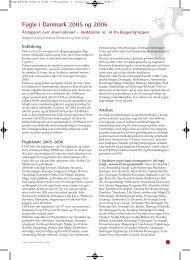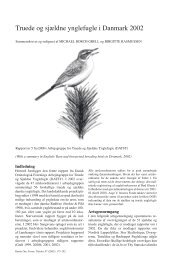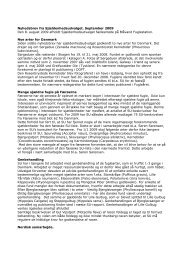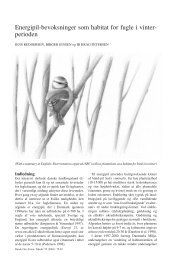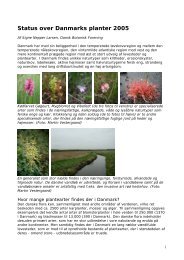Ynglefugle i Vejlerne - Dansk Ornitologisk Forening
Ynglefugle i Vejlerne - Dansk Ornitologisk Forening
Ynglefugle i Vejlerne - Dansk Ornitologisk Forening
You also want an ePaper? Increase the reach of your titles
YUMPU automatically turns print PDFs into web optimized ePapers that Google loves.
transect", has been undertaken every year. This transect<br />
showed a gradual increase to the best year 1996, yet uctuating<br />
en route. After 1996, and especially after 1999,<br />
there has been a very fast decrease, and 2000-03 saw the<br />
lowest numbers ever.<br />
In <strong>Vejlerne</strong> the Sedge Warbler is distributed along the<br />
edges of all larger reedbeds, often where willow bushes<br />
invade the reeds, and in surrounding agricultural lands<br />
under abandonment.<br />
In spite of the unexplainable almost-disappearance<br />
from the "Selbjerg transect" (which for many years was<br />
seen as a nucleus habitat for the species), many places<br />
exist in <strong>Vejlerne</strong> and in the surroundings where it is still<br />
common. No intent has been made to do a proper mapping<br />
of all Sedge Warbler territories in the whole of <strong>Vejlerne</strong>,<br />
but a qualied estimate was made in 2000 by an<br />
observer with a thorough knowledge of local conditions:<br />
1180 pairs (from 646 mapped territories and the rest approximated<br />
according to suitable habitat available). With<br />
a population of this magnitude <strong>Vejlerne</strong> is Denmark's<br />
most important area for the species. The national population<br />
was calculated at 3900 pairs in the 1990s, after the<br />
species disappeared from large parts of East Denmark.<br />
<strong>Vejlerne</strong> has a potential to remain a core area in the future,<br />
if management succeeds to preserve sufcient heterogeneity<br />
in the zones bordering reedbeds.<br />
Marsh Warbler was rst mentioned from <strong>Vejlerne</strong> in<br />
1973. In that year an advance took place north of the<br />
Limfjorden with new records in several places where<br />
the species never had been seen or heard before. Since<br />
1978 all singing males have been mapped each year (Table<br />
43). An increase has taken place during the period<br />
surveyed, in agreement with a general positive national<br />
trend, however somewhat larger variations have been<br />
seen in the <strong>Vejlerne</strong> material. Marsh Warbler has been<br />
found primarily in agricultural lands surrounding <strong>Vejlerne</strong>,<br />
especially in overgrown areas where former grazing<br />
has been abandoned.<br />
Reed Warbler. In areas where the reeds grow high and<br />
dense, Reed Warbler is common, and has been so since<br />
the earliest descriptions by ornithologists in the 1920s<br />
and 1930s. It is one of the most abundant species in the<br />
<strong>Vejlerne</strong> reserve; the population probably numbering<br />
thousands of pairs. As such the species is not subject to<br />
territory mapping, instead it is being monitored by line<br />
transect surveys, which have provided indexes for population<br />
trends (Table 44). The "Selbjerg transect", the only<br />
regularly implemented of these surveys, shows a marked<br />
increase (with uctuations), and the largest number was<br />
counted in 2003. It is assumed that variations in transect<br />
numbers express reactions to local conditions, even<br />
though more specic mechanisms are not known.<br />
During national point counts 1975-2005 the Danish<br />
Reed Warbler population has shown a long-term, signi-<br />
cant decrease of just over one percent a year, in spite<br />
of the breeding range having grown between nationwide<br />
atlas surveys in the 1970s and the 1990s. The "Selbjerg<br />
transect" gures compared to the national index from<br />
Breeding birds in <strong>Vejlerne</strong> 229<br />
point counts show a significant negative correlation.<br />
One explanation could be that the population is getting<br />
thinner in suboptimal habitat, while it thrives in large<br />
reedbeds.<br />
There is no doubt that <strong>Vejlerne</strong> constitutes the most<br />
important area for Reed Warbler in Denmark, just as it is<br />
the case for most other birds with reedbed afliation. By<br />
a cautious estimate the <strong>Vejlerne</strong> proportion of the national<br />
population is maybe 5-10%.<br />
Great Reed Warbler was registered for the rst time<br />
in <strong>Vejlerne</strong> (and in North Jutland) in 1971 with several<br />
singing males. From then on and until the late 1980s<br />
the species showed a constant occurrence with up to 9<br />
song territories in one year. However, after this period<br />
of stability for more than 15 years, there were no records<br />
or at the most a single bird registered on a single<br />
occasion (and therefore not considered a breeding bird)<br />
in most years 1988-2003 (Table 45, includes years previous<br />
to 1978).<br />
The birds coming to <strong>Vejlerne</strong> in 1971-87 are supposed<br />
to represent a population with a core of returning birds<br />
year after year, which is remarkable for a southeastern<br />
species on its nortwesternmost outpost. Great Reed Warbler<br />
needs a well-developed, healthy reedbed, hence rich<br />
opportunities ought to be present in <strong>Vejlerne</strong> from a habitat<br />
point of view, but as a marginal population it is sensitive<br />
to e.g. climatic variations. Also on a national scale<br />
few Great Reed Warblers reach Denmark in these years.<br />
Bearded Tit reached Denmark after reclamation projects<br />
in the Dutch polder during the 1960s resulted in the<br />
establishment of huge reedbeds, which in turn provided<br />
the possibilities for propagation of a large population of<br />
this species. First time the species was found breeding<br />
in this country was in 1967, including some in <strong>Vejlerne</strong>.<br />
There were records also from 1968-69, but after the cold<br />
winter of 1969-70 no birds were seen in <strong>Vejlerne</strong> for<br />
some years. Yet a rapid re-immigration happened, and<br />
for 1974 the reports mention 50-100 pairs. Before the<br />
start of the Field Observatory in 1978 some pretty harsh<br />
winters took another toll on the population. During Field<br />
Observatory years no intent has been made to map the<br />
population; we have merely entered all records of occurrences<br />
in the general database. Furthermore, in 1986 and<br />
1988-96 catching of birds for ringing took place in the<br />
reedbed. Here, this material is summed up and presented<br />
in various ways (Table 46).<br />
Hard winters still affect the species extensively, and<br />
the years 1979-85 and 1987 were entirely without records<br />
of Bearded Tits in <strong>Vejlerne</strong>. But since a new invasion<br />
took place in 1988 the species has been continuously<br />
present, and in few years the population grew<br />
to a large number. The details of the sequence of events<br />
depend on which statement method is chosen: largest annual<br />
sum and largest gure on a "Selbjerg transect" were<br />
in 2000, while the largest maximum count was in 2003.<br />
On the whole there is no doubt that the last years of the<br />
covered period saw a very large population in <strong>Vejlerne</strong>.<br />
Several times in the course of time it has been at


